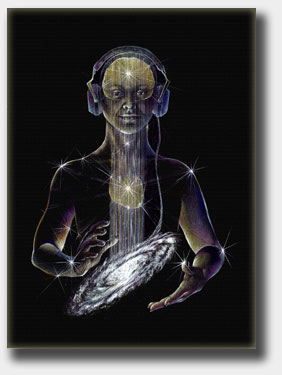Acoustic Brain Research

“ABR” Image – © 2012 Tom Kenyon.
All rights reserved.
An Important Note About Research Documents: Please Read First
The articles, reports, and studies in this section are being shared in the spirit of offering a free-flow of information. They are essentially educational in nature and will hopefully give you a glimpse into the workings of the brain in response to sound and music, as well as an understanding of Acoustic Brain Research (ABR) psychoacoustic technology.
But before you take a look, I feel it is imperative that I discuss some of the basic points regarding scientific research. I do this because, although I am offering the ABR psychoacoustic recordings for sale, I am also a lover of the scientific method. And in case some of you reading this aren’t scientists, I feel it obligatory to cover some of the basic principles of scientific research.
There are essentially three types of information in science — Anecdotal reports from individuals, Pilot Studies (sometimes called Anecdotal Studies), and Controlled Studies.
The scientific method requires quantification or a means of measuring. It is this objective standard that is the foundation of all scientific inquiry. Without quantification you do not have science.
The ABR Library of psychoacoustic recordings has been out in the field being used by therapists and laypersons throughout the world, in some cases, as long as twenty-three years (as of 2006). As a result, their usage has generated a large amount of anecdotal reports. We regularly get phone calls, letters and emails from people all over the globe who say that they have been helped by ABR recordings and programs. It is gratifying to see such accolades so often, but these reports are anecdotal, in that they are subjective reports from individuals and there is no quantification of data.
From the scientific perspective, anecdotal reports may indicate an area of possible focus or attention, but these types of information have no scientific significance. Significance in science is based upon measurement or quantification.
The second type of information in scientific inquiry is the Pilot Study. These studies usually involve a very small sample of subjects (sometimes as small as one), and in such cases these studies of one subject are often called Anecdotal Studies. There is always some form of measurement involved, and this gives these types of studies a little more scientific significance and credibility than anecdotal reports.
The primary method we used to research the technology that eventually became the foundation of ABR psychoacoustic recordings was EEG Topographical Brain Mapping. This method gives a wealth of statistical information about brain state in the surface areas of the brain (the neocortex). As part of this research, we often conducted small anecdotal studies when I had developed a new aspect of psychoacoustic technology. And that is most of what you will find in this section.
I want to be very clear here. Although Pilot Studies offer some modicum of quantification, we would be remiss if we jumped to conclusions, and decided that the results experienced by any one person, or a few persons, can be generalized to everyone. This is why the third form of scientific research is so important-the Controlled Study. In these types of studies, a large sample of subjects is vital. It is this sampling of data from a large pool of subjects that allows researchers to predict whether the same results experienced by one individual are likely to be experienced by others.
ABR’s psychoacoustic technology was developed primarily, with a few exceptions, through a combination of clinical observation and Pilot Studies. In other words, we studied a small sample of subjects (via EEG) and then predicted possible effects. These effects were then observed in a clinical setting with a much larger group of persons-mostly in my psychotherapy office, in individual or group sessions, and by other therapists throughout the world. It is important, I think, to keep these distinctions in mind as you read over the studies and comments in this section.
Psychoacoustics is a growing field of interest both by laypersons, therapists and by medical and mental health professionals. It is my hope that by presenting this information in a scientifically accurate manner, this emerging technology of personal transformation will be served.
Tom Kenyon, M.A.
Tom Kenyon is a researcher, a therapist, a musician, sound healer and teacher. For over twenty years his research group, Acoustic Brain Research, has been a leader in the field of psycho-acoustics and the use of sound and music to access the creative abilities of the brain and mind. The ABR Library has both science and a proven track record behind it and is in use by therapists, clinicians and by laypersons all over the world.Important Note: ABR recordings are designed for the purpose of education and self-exploration only.
BioPulse Technology™
ABR’s psychoacoustic technology is based on the use of complex tonal matrices in which various sound patterns are mixed to stimulate the brain/mind into more resourceful states. Many of these tones are mixed beneath the level of audible hearing, masked by other sounds, and sometimes music, specifically composed for the desired mental/emotional state.
Tom Kenyon’s ABR recordings also take advantage of “BioPulse Technology” in which specific tones, known to affect brain state, are mixed into the tonal matrix. Research indicates that such frequencies can significantly alter awareness.
These primary categories are:
delta (0.5 – 4 HZ). Associated with deep levels of relaxation such as sleep
theta (4 – 8HZ). Associated with tranquil states of awareness in which vivid internal imagery can often occur
alpha (8- 12 HZ). Relaxed nervous system, ideal for stress management, accelerated learning and mental imagery
beta (12-30 HZ). Associated with waking/alert states of awareness k-complex (30 – 35HZ). Clarity and sudden states of integration, the “ah-ha experience”
super high beta (35 – 150 HZ). Psychodynamic states of awareness



